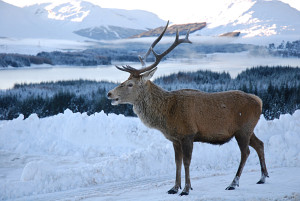 To avoid accidents, motorists should slow down and be on the lookout for deer on the road in May, warns Scottish Natural Heritage (SNH).
To avoid accidents, motorists should slow down and be on the lookout for deer on the road in May, warns Scottish Natural Heritage (SNH).
Vehicle accidents involving deer peak at this time of year, as yearling animals disperse, looking for their own territories. Because of this, SNH, in conjunction with Transport Scotland, are placing warning messages on variable messaging signs on high-risk trunk roads across Scotland from Monday, 29 April to Friday, 31 May.
The signs are targeted on roads with higher rates of deer-vehicle collisions, covering areas of the Central Belt around Glasgow and Edinburgh, as well as Stirling, Kinross, Perth, Dundee, Aberdeen and Inverness. Signs warn motorists of the high risk of deer on road.
The most recent deer-vehicle collisions research shows there are more than 7000 collisions between motor vehicles and deer every year in Scotland, with an average of 65 of these resulting in human injuries. The combined economic value of these accidents, through human injuries and significant damage to vehicles is £7 million. Across the UK, it’s estimated there are between 42,000 and 74,000 deer-vehicle related accidents a year, resulting in 400 to 700 human injuries and about 15 deaths, with an annual cost approaching £47m.
The Deer Vehicle Collisions Project reports that the road sections with highest recent accident rates at this time of year include the A9 (Dunblane to Perth; Bankfoot to Pitlochry;); A85 (Methven to Perth); A90 (Dundee to Brechin; Stonehaven to Aberdeen); M80 (J1 to A80M Haggs); and A1 (Mussleburgh to Lamberton). The areas with the greatest numbers of urban area deer vehicle-collisions are centred on Glasgow and Aberdeen.
Dr Jochen Langbein of the Deer Initiative, said: “The fact that only around one-fifth of all UK deer-vehicle collisions occur in Scotland doesn’t mean the risk to drivers here is any lower. On the contrary, the risk of deer collisions per driven mile is actually greater in Scotland, as total traffic volumes in England are nine times higher than in Scotland.”
Sinclair Coghill, SNH wildlife management officer, said: “We should all be aware of the risk of deer on the road when we’re driving, especially at this time of year. This is becoming more and more of an issue in the Central Belt and around our towns and cities – it’s not just a problem on remote Highland roads, as many people think.
“We’d ask motorists to slow down and watch for deer crossing in front of traffic. Be particularly alert if you’re driving near woods where deer can suddenly appear before you have time to brake. If you do hit a deer, report it to the police, as the deer may be fatally injured and suffering.”
Other tips include:
– Try not to suddenly swerve to avoid hitting a deer. A collision into oncoming traffic could be even worse.
– Only break sharply and stop if there is no danger of being hit by following traffic. Try to come to a stop as far away from the animals as possible to allow them to leave the roadside without panic, and use your hazard warning lights.
– After dark, use full-beams when there is no oncoming traffic, as this will illuminate the eyes of deer on or near a roadway and give you more time to react. But dim your headlights when you see a deer or other animal on the road so you don’t startle it.
– Report any deer-vehicle collisions to the police, who will contact the local person who can best help with an injured deer at the roadside. Do not approach an injured deer yourself – it may be dangerous.
